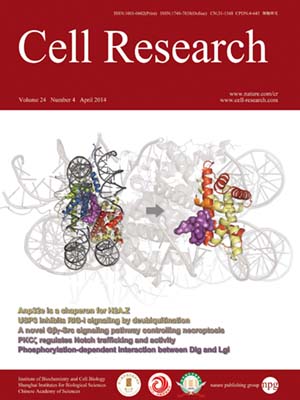
Volume 24, No 4, Apr 2014
ISSN: 1001-0602
EISSN: 1748-7838 2018
impact factor 17.848*
(Clarivate Analytics, 2019)
Volume 24 Issue 4, April 2014: 417-432
ORIGINAL ARTICLES
The Gβγ-Src signaling pathway regulates TNF-induced necroptosis via control of necrosome translocation
Lisheng Li1,*, Wanze Chen1,*, Yaoji Liang1,*, Huabin Ma1, Wenjuan Li1, Zhenru Zhou1, Jie Li1, Yan Ding1, Junming Ren1, Juan Lin1, Felicia Han1, Jianfeng Wu1 and Jiahuai Han1
1State Key Laboratory of Cellular Stress Biology, Innovation Center for Cell Biology, School of Life Sciences, Xiamen University, Xiamen, China
Correspondence: Jiahuai Han, E-mail: jhan@xmu.edu.cn;(jhan@scripps.edu)
Formation of multi-component signaling complex necrosomes is essential for tumor necrosis factor α (TNF)-induced programmed necrosis (also called necroptosis). However, the mechanisms of necroptosis are still largely unknown. We isolated a TNF-resistant L929 mutant cell line generated by retrovirus insertion and identified that disruption of the guanine nucleotide-binding protein γ 10 (Gγ10) gene is responsible for this phenotype. We further show that Gγ10 is involved in TNF-induced necroptosis and Gβ2 is the partner of Gγ10. Src is the downstream effector of Gβ2γ10 in TNF-induced necroptosis because TNF-induced Src activation was impaired upon Gγ10 knockdown. Gγ10 does not affect TNF-induced activation of NF-κB and MAPKs and the formation of necrosomes, but is required for trafficking of necrosomes to their potential functioning site, an unidentified subcellular organelle that can be fractionated into heterotypic membrane fractions. The TNF-induced Gβγ-Src signaling pathway is independent of RIP1/RIP3 kinase activity and necrosome formation, but is required for the necrosome to function.
10.1038/cr.2014.17
FULL TEXT | PDF
Browse 2506


